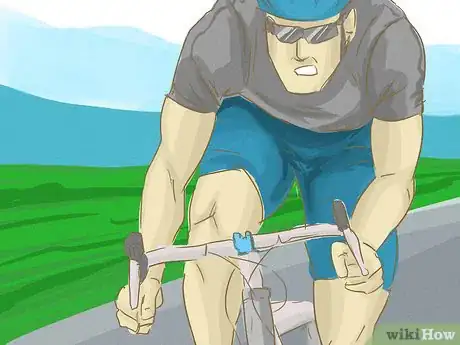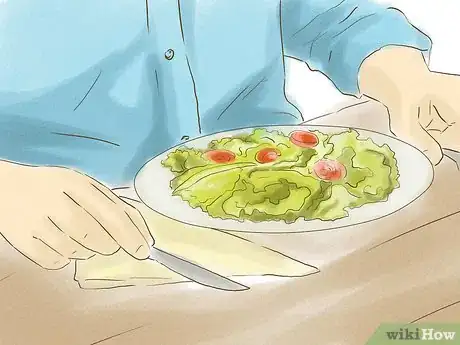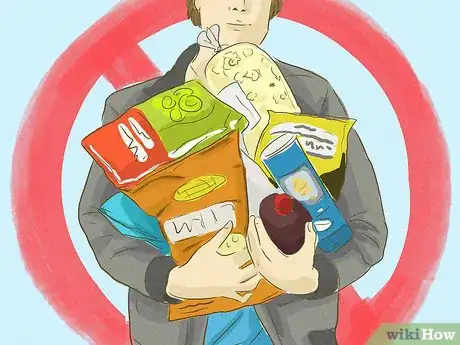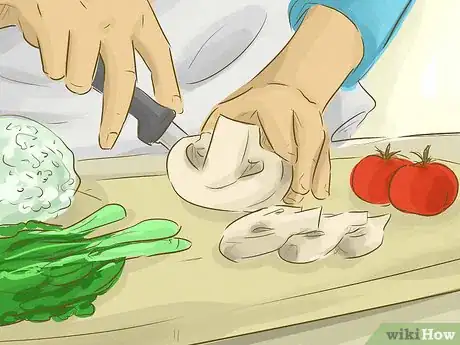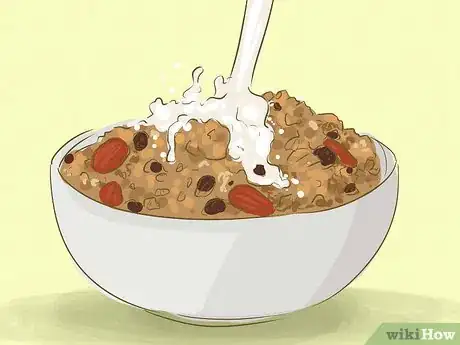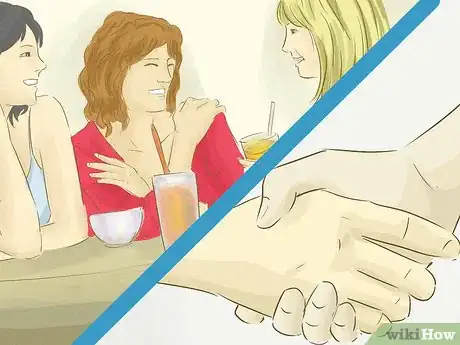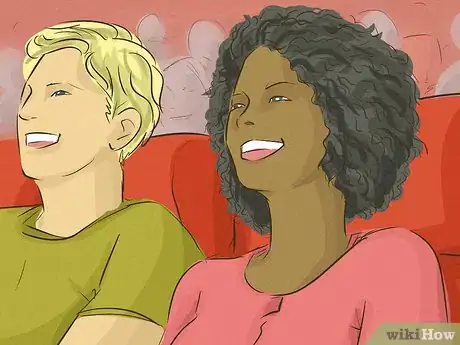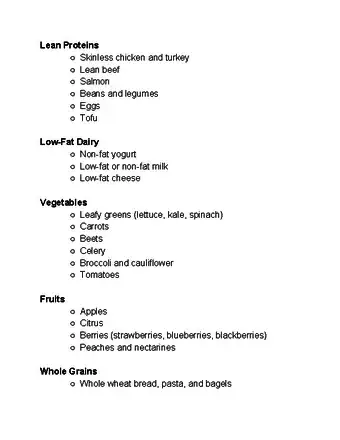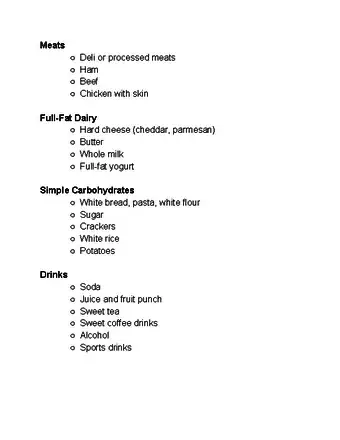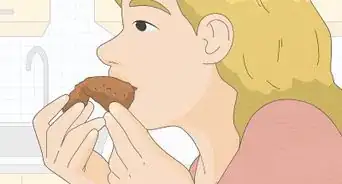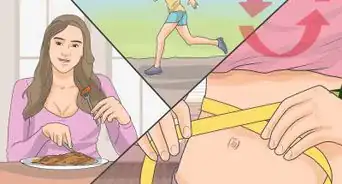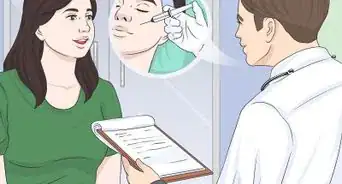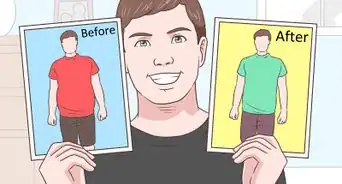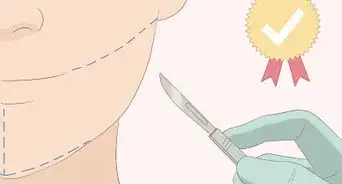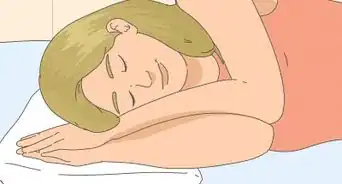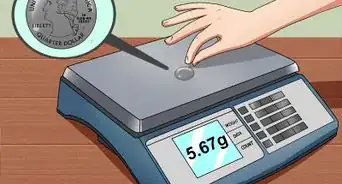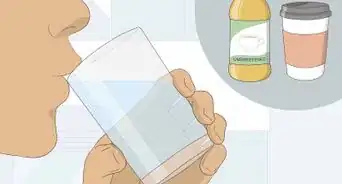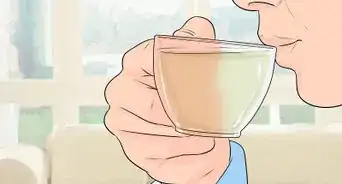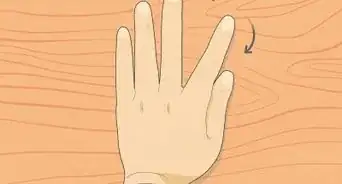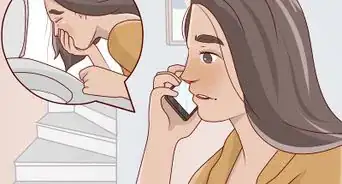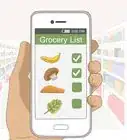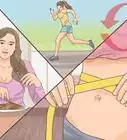This article was co-authored by Pouya Shafipour, MD, MS. Dr. Pouya Shafipour is a Family Medicine Specialist, Primary Care Physician, and a Weight Loss Specialist based in Santa Monica, California. Dr. Shafipour specializes in dietary, nutritional, behavioral, and exercise counseling to manage obesity and medical conditions related to excessive weight gain or loss. Dr. Shafipour received a BS in Molecular and Cell Biology from the University of California, Berkeley, an MS in Physiology and Biophysics from Georgetown University, and an MD from the Loma Linda University School of Medicine. He completed his internship in general surgery at UC Irvine and a residency in family medicine at the University of California, Los Angeles, and became board certified in family medicine in 2008.
There are 15 references cited in this article, which can be found at the bottom of the page.
wikiHow marks an article as reader-approved once it receives enough positive feedback. This article received 23 testimonials and 83% of readers who voted found it helpful, earning it our reader-approved status.
This article has been viewed 4,735,726 times.
There are many reasons why you might want to lose weight. If you have been significantly overweight or obese for a long time, then you might have concerns about what the extra weight could be doing to your health. Obesity increases your risk of many health problems, including diabetes, non-alcoholic fatty liver disease, gallbladder disease, and some types of cancer. If you have recently gained a bit of weight, then you might just want to lose some weight to fit back into your old jeans. Whatever your reason for wanting to lose weight, there are some important strategies that you should know about.
Steps
Eating Right
-
1Choose fibrous proteins instead of fatty ones. Protein is important for organ function and building muscle. Select lean cuts of beef or extra-lean ground beef when you're consuming red meat. Remove skin from chicken before cooking.
- Skip the fatty deli meats like bologna and salami. Choose lean turkey or roast beef as a replacement.
- Vegetarians can get plenty of protein from soy, nuts, beans, and seeds. Lentils, legumes, and beans are excellent sources of fiber and protein.
- Eat low-fat dairy for a source of protein, including low-fat cheeses and nonfat yogurt. A 150-gram serving of Greek yogurt provides about 11 grams of protein. The study has shown that 20 women who were eating high-protein yogurt snacks instead of crackers, chocolate, and other low-protein snacks consumed fewer calories and experienced less hunger.[1]
-
2Eat more fruits and vegetables. Fruit helps to satisfy your sweet tooth thanks to its natural sugars, while fresh vegetables help your stomach fill up more quickly. Fruits and vegetables contain fiber to help you feel full quickly. Try some of these tips to introduce more fruit and vegetables into your diet:
- Eat what is in season and eat fruit and vegetables for snacks or, for dessert. When you eat apples in the fall, for instance, or cherries in late summer, it might as well be an indulgent dessert. Cut up celery, carrots, peppers, broccoli or cauliflower and dip them in a light salad dressing or hummus.
- Use vegetables as a main dish. For example, make a stir-fry or a hearty salad and add just a few ounces of cooked chicken, salmon or almonds.
Advertisement -
3Eat more whole grains and cut simple carbs. Whole wheat bread, oatmeal, whole wheat pasta, sweet potato, and brown rice are all excellent sources of energy and sources of nutrition. Combined with the right combination of proteins and vegetables, whole grains are perfect all-around nutrition.
- Simple carbs are things like white bread, processed flour, and white sugar. This gives you energy quickly but then comes with a crash. It turns into fat very quickly.
- Substitute whole wheat flour or oat flour into pancakes or baked goods. You might need to add additional leavening ingredients, like baking powder or yeast. Put barley in your soup instead of rice or try a pilaf with barley, wild rice or brown rice.
- Eat only naturally-occurring carbohydrates instead of processed carbohydrates. Avoid processed foods, like white bread, semolina pasta or crackers, or processed sweets like candy bars or sugary vegetables.[2]
-
4Try a formal diet plan. If you like the idea of following a more specific diet and putting the planning into someone else's hands, try following a new diet and exercise:
- Follow a paleo diet and eat grass-produced meat, fish, and seafood, fresh fruits, and vegetables, eggs, seeds, and nuts, just like paleo-humans did. Eat nothing prepackaged or processed.[3]
- Try sticking to raw foods. The Raw Food Diet requires 75 percent of your dietary intake to be uncooked. Most people eat a lot of fruits and vegetables, whole grains, nuts, and beans.[4]
- Join a commercial diet plan. If you prefer to eat whatever you want and to meet weekly with other people who are losing weight, then try WW (formerly known as Weight Watchers). If you prefer prepared meals so that you don't have to cook, try Jenny Craig or NutriSystem.
-
5Cut the salt from your diet. Eating more sodium causes your body to retain water, which can cause you to feel bloated and gain more weight. The good news is that you'll sweat that weight out very quickly, so an easy way of cutting some pounds is to eat less sodium in your diet.
- Instead of salt, try spicing your meals with chili flakes, fresh salsa, or cajun spices and seasonings.
- Unsalted foods will taste much saltier eventually if you cut salt out for a while and let your taste buds re-acclimate.
-
6Don't skip meals. Lots of people think skipping a meal will help to lose weight, but people who have lost weight tend to maintain their weight loss better when they eat three meals and two snacks every day.[5] This indicates that eating three meals and two snacks may be a healthy eating pattern for weight loss.
- Make sure that you don't get hungry by eating small portions throughout the day at regular intervals. Between your meals, eat a 150-calorie snack to keep your metabolism burning and to stave off hunger. Be sure that you don't eat a fattening snack such as sweets or crisps. When you're hungry, your body conserves calories and slows down your metabolic processes.
-
7Avoid sweetened drinks. Drinks that are sweetened, whether artificially or naturally, will have little nutritional value and add lots of empty calories to your diet. Do not drink fruit juice or other sweetened drinks. Even natural sugars will increase your daily calorie intake and prevent weight loss. If you chose to drink juice, do not exceed 4 oz per day (1/2 cup). Instead of drinking sweetened beverages throughout your day, drink unsweetened, calorie-free beverages.[6] Some beverages to avoid include:
- Soda
- Juice
- Sweet tea
- Kool Aid
- Fruit punch
- Sports drinks
- Sweet coffee drinks
- Alcoholic drinks
Losing Weight Basics
-
1Control your portions. One reason why you might have gained weight is due to eating portions that are too large. To start losing weight, you will need to eat smaller portions. Eating smaller portions can also help you to keep eating some of your favorite foods while still losing weight.
- For example, before loading up your plate with half a frozen pizza, check the label to see what a portion size is and only put this amount on your plate.
- Or, if you want to have a bowl of cereal, check the box to see how much you can have for one serving and use a measuring cup to get the exact amount.
- Controlling portions doesn't have to mean you're hungry all the time if you try strategies to make yourself feel more full.
-
2Write down everything you eat this week. People who keep food diaries, according to a study published in the Journal of the Academy of Nutrition and Dietetics, lose an average of 6 pounds (2.75 kg) more than people who don't keep a record of everything that they eat.[7] So force yourself to write down the good, the bad and the ugly. Keep these tips in mind:
- Be complete. Write it all down, including beverages, condiments, and a description of how the food was prepared. Don't pretend you didn't have that extra glass of wine after dinner. If it goes into your stomach, it goes into the journal.
- Be accurate. Record your portion sizes in your food diary. Don't eat too little or too much - keep track. Also, read the ingredients list so that you can be accurate about serving sizes.
- Be consistent. Carry your food journal everywhere that you go. As an alternative, you can use a diet-tracking app on your smartphone or tablet.
-
3Figure out how many calories you should eat each day to lose weight. Losing weight isn't all about weight. The more aware you are of the calories in the food you eat, the more easily you'll be able to eat the right amount of food and do the right amount of exercise to drop a couple of pounds. Take your food journal and look up each item individually. Keep a running tally and add up your calorie total for the day.
- Next, look up how much a person of your age, height, weight, and energy level needs per day in calories.
- Add about 170 calories to your total. Recent studies estimate that we tend to eat slightly more than we're able to keep track of in a day.[8]
-
4Make a meal plan, and stick to it. Decide what you're going to eat this week before you're standing at the fridge and trying to figure it out on the fly. Buy the right healthy ingredients to eat the way you want to eat, and plan it out by the calorie.
- Be realistic. If you like to eat out a lot, don't try to totally eliminate eating out. Instead, plan on eating home-cooked meals six days a week.
- Cut down on the snacking, or try to make them healthy snacks. Fresh vegetables with guacamole, unsalted almonds, or fruit make for great weight-loss snacks.
- Let yourself have non-food treats. Promise yourself that if you can follow this for six weeks and exercise (if that is one of your goals), you will treat yourself to a pedicure or a massage.
- Work indulgence foods into your calorie plan. If you do want to have something that is a little higher in calories, then make sure that you work it into your overall calorie goal for the day. For example, if you are following a 1,800 calorie plan, and you want to have a brownie that is 300 calories, then you would only have 1,500 calories left for the day.
-
5Eat fewer calories than you burn. The only surefire way to lose weight is to eat less than you burn over the course of a day. Sounds simple, but it takes work and consistency. That means exercise. If you want to lose weight and stay healthy, you need to start exercising. Aim for 15-30 minutes of exercise 3-5 times a week to get started.[9]
- Try to tally your energy-output each day. It's helpful to keep track of these with pedometers, or other weight-loss tracking apps that you can use to make this easier. Read the section about exercise for more specific tips.
- Set mini-goals. Your ultimate goal might be to lose 20 pounds, but instead of focusing on that, think that you want to lose 1 to 2 pounds (0.45 to 0.91 kg) this week. Or you can focus on non-pound goals like skipping after-dinner snacks this week or only drinking alcohol on weekends.
- It is important to understand that weight is entirely a function of input and output. The input is the food you eat and the calories contained therein. The output is your energy output. To lose weight the output needs to be greater than the input. It is that simple. Do not believe any of the diet fads. If you are currently not gaining or losing weight then just burning 300 extra calories per week or eating/drinking 300 calories less per week (2 sodas for example or a small burger) WILL make you lose weight - in this case around 5 pounds of fat per year.
-
6Drink at least 2 liters (2.1 U.S. qt) of water each day. Water has the double effect of both hydrating your body and filling your stomach with a certain volume of a liquid that has zero calories. The Institute of Medicine determined that an adequate intake (AI) for men is roughly 3 liters (0.8 US gal) (about 13 cups) of total beverages a day. The AI for women is 2.2 liters (about 9 cups) of total beverages a day.[10]
- Drinking water about 30 minutes before meals can reduce the number of calories people end up consuming, especially in older individuals.
- Research showed that dieters who drank half a liter of water before meals lost 44% more weight over a period of 12 weeks, compared to those who didn’t.[11]
Exercising
-
1Start doing basic aerobic and cardio exercise. Start with a small goal of 30 minutes, 3 times per week if you aren't exercising at all currently. Try these steps to get yourself going:[12]
- Buy a pedometer. Attach the pedometer to your belt and try to take 5,000 steps daily. Move up to a goal of 10,000 to 15,000 steps as you get in better shape.
- Start by walking to lose weight. Walking around your neighborhood costs nothing and is a great way to start moving. You can also try other low-impact exercises like swimming, riding a bike or jogging.
-
2Try machines at the gym. You can use a treadmill, an elliptical trainer, a stationary bike, a rowing machine or a stair climber. Start with short sessions and gradually add minutes as you get more fit. Also, use the settings on the machines to increase the intensity as you lose weight.
- Do a variety of different machines until you find something you like. Consult a personal trainer to make sure you're using proper form to avoid injury. They're there to help, not to intimidate you.
-
3Take an aerobics class. You can take a traditional aerobics class or try any number of movement-based exercise routines. These are great ways of keeping yourself motivated in a group, having fun moving around, and losing weight. Try any of the following:
- Kickboxing
- Jazzercise
- Zumba
- Pilates
- Yoga
- Martial arts
- Crossfit or Bootcamp
-
4Get into strength training. Start small, aiming for one or two 15-minute sessions per week until you feel motivated to do more. Exercise large muscle groups to burn more calories and lose weight, instead of focusing on specific muscles. Try some of these examples:
- Start with squats paired with an overhead dumbbell press to work your lower body and upper body at the same time.
- Perform resistance exercises while sitting or reclining on an exercise ball. You'll strengthen your core while simultaneously working on other areas.
- Use machines and free weights. These tools tend to focus on particular muscle groups like the arms, shoulders, thighs, glutes and upper back. Do these more focused exercises after you work on exercises for multiple muscle groups.
- Rest at least one full day between strength training workouts so that your muscles can recover. Recovery will help you to avoid pain and injury.
-
5Play a sport. If you're not into the idea of exercise for the sake of exercise, try finding a fun activity that you enjoy, which has the added benefit of getting you moving. Find an intramural league in your town, or just get together with some friends to play a pick-up game every now and then.
- If you don't like competitive sports, try doing something that you can do by yourself. Swim, or play golf, or go hiking instead of playing a game with a ball and a net.
- Get a bicycle if you want to find a great way to get around and exercise at the same time. Don't spend all that time sitting down in your car when you could be burning calories.
- Also, try going on a walk after dinner for 40 minutes-1 hour. During this time, your body goes into fat-burning mode until you eat in the morning. Make sure to do this after dinner, because eating anything but protein will take you out of the fat-burning mode and make sure to eat a good breakfast.
Staying Motivated
-
1Find creative ways to eat less. While doing these things alone won't necessarily make you lose weight, they can be helpful little tricks to keep you moving on the right path. Try out the following to help your hunger cravings during the day:
- Eat three fewer bites of each meal.
- Put your knife and fork down between bites.
- Use smaller plates, and fill your plate only once.
- Wait to eat until you feel hungry, don't just snack when you're bored.
-
2Find creative ways to manage your cravings. If you're used to big snacks and indulgent meals, it's no secret that dieting and switching to exercise is challenging. But learning to manage your cravings for a big slice of cake or a greasy hamburger is possible, with a little creativity.
- Smell fresh fruit when you want a snack, instead of eating something.
- "Close" your kitchen between meals.
- Don't keep sugary or fattening snacks in the house.
- Some studies show that the color blue is an appetite suppressant. Try getting a blue tablecloth, or blue dishes to eat on.
-
3Eat at home. Going out to eat makes it too easy to cheat. Food sold at restaurants is commonly much higher in fat, sodium, and other weight-loss killers. The portions are also often much larger than what you might usually eat at home, as well. Instead of heading out, try to make your own meals.
- Eat in a small group, instead of a large one. Some research shows that people eating at big tables tend to eat more than people eating alone.[13]
- Don't eat while you do other things, in general. Watching television, or reading, or working while you eat often causes people to eat much more food than they normally would.
-
4Eat cereal for breakfast. One recent study revealed that people who eat cereal for breakfast each day have a much easier time losing weight than people who eat other types of breakfast. Start your day right with a high-fiber, nutrient rich natural cereal, or oatmeal.[14]
- Switch to skim milk with breakfast and for use in other dishes. Each lower-fat step you take down, you're losing 20% of the calories. Switching to a low-fat version of milk is an excellent way to cut down on the calories you're taking in, without having to sacrifice any of the nutritional benefits.
-
5Decide to lose weight in a group.[15] Commit to losing a certain amount of weight by a certain date with the caveat that you'll pay up if you don't lose. You may enjoy starting up a Biggest Loser Club at work or with your friends, or you can investigate a weight loss betting website.
-
6Give yourself a treat now and then. If you're attending a party or going out for a special occasion, allow yourself an indulgence. Just make sure that these indulgences don't become daily habits.[16] Don't let a single slip-up derail your diet and exercise plan. Get back to it, even if you forget for a day or two.
- Try using non-food rewards as well. When you do something right with your diet and exercise, treat yourself to something. Go to a game with a friend, or get a manicure, a massage or a trip to the movies when you meet your mini-goals. Get yourself that new shirt that you've been wanting if you meet your goal of losing a pound this week.
Sample Diet
Expert Q&A
Did you know you can get expert answers for this article?
Unlock expert answers by supporting wikiHow
-
QuestionWhat are the best vitamins for losing weight?
 Pouya Shafipour, MD, MSDr. Pouya Shafipour is a Family Medicine Specialist, Primary Care Physician, and a Weight Loss Specialist based in Santa Monica, California. Dr. Shafipour specializes in dietary, nutritional, behavioral, and exercise counseling to manage obesity and medical conditions related to excessive weight gain or loss. Dr. Shafipour received a BS in Molecular and Cell Biology from the University of California, Berkeley, an MS in Physiology and Biophysics from Georgetown University, and an MD from the Loma Linda University School of Medicine. He completed his internship in general surgery at UC Irvine and a residency in family medicine at the University of California, Los Angeles, and became board certified in family medicine in 2008.
Pouya Shafipour, MD, MSDr. Pouya Shafipour is a Family Medicine Specialist, Primary Care Physician, and a Weight Loss Specialist based in Santa Monica, California. Dr. Shafipour specializes in dietary, nutritional, behavioral, and exercise counseling to manage obesity and medical conditions related to excessive weight gain or loss. Dr. Shafipour received a BS in Molecular and Cell Biology from the University of California, Berkeley, an MS in Physiology and Biophysics from Georgetown University, and an MD from the Loma Linda University School of Medicine. He completed his internship in general surgery at UC Irvine and a residency in family medicine at the University of California, Los Angeles, and became board certified in family medicine in 2008.
Weight Loss Specialist There are no magical vitamins that are going to help you cut weight. It's really all about eating healthy and exercising. However, if you have specific dietary needs or nutrient deficiencies, you may benefit from certain supplements. For example, if you're on a ketogenic diet, you may need B vitamin supplements. Still, you should talk to your doctor before you start taking anything for your diet.
There are no magical vitamins that are going to help you cut weight. It's really all about eating healthy and exercising. However, if you have specific dietary needs or nutrient deficiencies, you may benefit from certain supplements. For example, if you're on a ketogenic diet, you may need B vitamin supplements. Still, you should talk to your doctor before you start taking anything for your diet. -
QuestionHow can I prevent obesity later in life?
 Pouya Shafipour, MD, MSDr. Pouya Shafipour is a Family Medicine Specialist, Primary Care Physician, and a Weight Loss Specialist based in Santa Monica, California. Dr. Shafipour specializes in dietary, nutritional, behavioral, and exercise counseling to manage obesity and medical conditions related to excessive weight gain or loss. Dr. Shafipour received a BS in Molecular and Cell Biology from the University of California, Berkeley, an MS in Physiology and Biophysics from Georgetown University, and an MD from the Loma Linda University School of Medicine. He completed his internship in general surgery at UC Irvine and a residency in family medicine at the University of California, Los Angeles, and became board certified in family medicine in 2008.
Pouya Shafipour, MD, MSDr. Pouya Shafipour is a Family Medicine Specialist, Primary Care Physician, and a Weight Loss Specialist based in Santa Monica, California. Dr. Shafipour specializes in dietary, nutritional, behavioral, and exercise counseling to manage obesity and medical conditions related to excessive weight gain or loss. Dr. Shafipour received a BS in Molecular and Cell Biology from the University of California, Berkeley, an MS in Physiology and Biophysics from Georgetown University, and an MD from the Loma Linda University School of Medicine. He completed his internship in general surgery at UC Irvine and a residency in family medicine at the University of California, Los Angeles, and became board certified in family medicine in 2008.
Weight Loss Specialist
-
QuestionWhich type of fat is good for you?
 Pouya Shafipour, MD, MSDr. Pouya Shafipour is a Family Medicine Specialist, Primary Care Physician, and a Weight Loss Specialist based in Santa Monica, California. Dr. Shafipour specializes in dietary, nutritional, behavioral, and exercise counseling to manage obesity and medical conditions related to excessive weight gain or loss. Dr. Shafipour received a BS in Molecular and Cell Biology from the University of California, Berkeley, an MS in Physiology and Biophysics from Georgetown University, and an MD from the Loma Linda University School of Medicine. He completed his internship in general surgery at UC Irvine and a residency in family medicine at the University of California, Los Angeles, and became board certified in family medicine in 2008.
Pouya Shafipour, MD, MSDr. Pouya Shafipour is a Family Medicine Specialist, Primary Care Physician, and a Weight Loss Specialist based in Santa Monica, California. Dr. Shafipour specializes in dietary, nutritional, behavioral, and exercise counseling to manage obesity and medical conditions related to excessive weight gain or loss. Dr. Shafipour received a BS in Molecular and Cell Biology from the University of California, Berkeley, an MS in Physiology and Biophysics from Georgetown University, and an MD from the Loma Linda University School of Medicine. He completed his internship in general surgery at UC Irvine and a residency in family medicine at the University of California, Los Angeles, and became board certified in family medicine in 2008.
Weight Loss Specialist There are a few different categories of fat: saturated, unsaturated, monosaturated, polyunsaturated, and trans fat. You want to stay away from trans fats and you don't want to eat too many saturated fats, but there are healthy fats out there. Olives, olive oils, fatty fish, walnuts, and avocado are all healthy forms of fat. A small amount of grass-fed beef isn't the end of the world either, so long as it isn't pumped full of hormones.
There are a few different categories of fat: saturated, unsaturated, monosaturated, polyunsaturated, and trans fat. You want to stay away from trans fats and you don't want to eat too many saturated fats, but there are healthy fats out there. Olives, olive oils, fatty fish, walnuts, and avocado are all healthy forms of fat. A small amount of grass-fed beef isn't the end of the world either, so long as it isn't pumped full of hormones.
Warnings
- Do not deprive yourself of food. Make sure to eat at least three meals per day.[19]⧼thumbs_response⧽
- If you're breastfeeding, pregnant, or chronically ill, talk to your doctor before starting a weight loss program.[20]⧼thumbs_response⧽
- Avoid losing more than one to two pounds (0.5 to 1 kg) per week whenever possible. Faster weight loss may cause you to lose muscle mass instead of fat. Also, people have more difficulty maintaining rapid weight loss over the long term.[21]⧼thumbs_response⧽
Things You'll Need
- Healthy foods
- Pedometer or FitBit
- MP3 player or iPod
- YouTube videos and/or DVDs
- Athletic shoes
- Workout clothes
- Food diary
- Food scale
- Measuring cups and spoons
- Water
References
- ↑ https://www.ncbi.nlm.nih.gov/pubmed/25266206
- ↑ https://www.mayoclinic.org/healthy-lifestyle/weight-loss/in-depth/low-carb-diet/art-20045831
- ↑ http://thepaleodiet.com/what-to-eat-on-the-paleo-diet-paul-vandyken/
- ↑ http://www.webmd.com/food-recipes/guide/raw-food-diet
- ↑ https://www.ncbi.nlm.nih.gov/pubmed/22027056
- ↑ Pouya Shafipour, MD, MS. Board Certified Family Medicine Specialist. Expert Interview. 8 May 2020.
- ↑ https://www.fhcrc.org/en/news/releases/2012/07/want-to-lose-weight--keep-a-food-journal--don-t-skip-meals-and-a.html
- ↑ http://www.rd.com/health/diet-weight-loss/how-to-lose-weight/
- ↑ Pouya Shafipour, MD, MS. Board Certified Family Medicine Specialist. Expert Interview. 8 May 2020.
- ↑ http://www.mayoclinic.org/healthy-lifestyle/nutrition-and-healthy-eating/in-depth/water/art-20044256
- ↑ https://www.ncbi.nlm.nih.gov/pubmed/19661958
- ↑ http://www.webmd.com/fitness-exercise/features/how-start-exercise-program
- ↑ http://www.rd.com/health/diet-weight-loss/how-to-lose-weight/
- ↑ http://www.rd.com/health/diet-weight-loss/how-to-lose-weight/
- ↑ http://thechart.blogs.cnn.com/2012/05/28/would-you-lose-weight-if-money-were-at-stake/
- ↑ Pouya Shafipour, MD, MS. Board Certified Family Medicine Specialist. Expert Interview. 8 May 2020.
- ↑ http://www.choosemyplate.gov/oils
- ↑ http://www.self.com/health/2012/07/weighing-yourself-too-much?currentPage=1
- ↑ Pouya Shafipour, MD, MS. Board Certified Family Medicine Specialist. Expert Interview. 8 May 2020.
- ↑ http://www.nlm.nih.gov/medlineplus/ency/patientinstructions/000586.htm
- ↑ https://www.mayoclinic.org/healthy-lifestyle/weight-loss/expert-answers/fast-weight-loss/faq-20058289
About This Article
To lose weight, you need to combine detailed tracking of your caloric intake with a carefully selected variety of healthy foods and regular exercise. Use a calorie counting smartphone app or website to keep a detailed record of the calories you eat each day. The best calorie counting apps have databases with accessible information about the calories of most foods and recipes, and can help you track your eating over time. Choose to eat lean proteins such as chicken breast, salmon, or tofu; a wide variety of green and leafy vegetables; as well as a selection of fruits and whole grains. Swap out unhealthy fats like butter for healthy choices like olive oil. Avoid alcoholic beverages, which are high in calories, and can also stimulate your appetite. Try eating several small meals throughout the day instead of a few larger meals. This will help keep your energy levels up and prevent you from getting too hungry. Also, drink plenty of cool water to stay hydrated, which can help keep you fuller longer. Avoid juice, soda, and other sweetened drinks. It is important to reduce your daily calorie intake, but don't eat fewer than 1200 calories a day, which can trigger your body's starvation response and slow your weight loss. Also, aim for a minimum of 30 minutes of moderate-to-vigorous exercise each day. Depending upon your level of fitness, you can get the exercise you need by walking, running, swimming, cycling, or taking a class at the gym. Mix things up with strength training. You don't need any special equipment – body weight exercises such lunges, squats, and push-ups can all help you get toned and burn fat. Find friends or family to work on losing weight with you so that you can support each other. With consistent attention to diet and exercise, you'll lose weight in a healthy, sustainable, way. To learn more from our Dietitian co-author, like how to make a meal plan, keep reading!
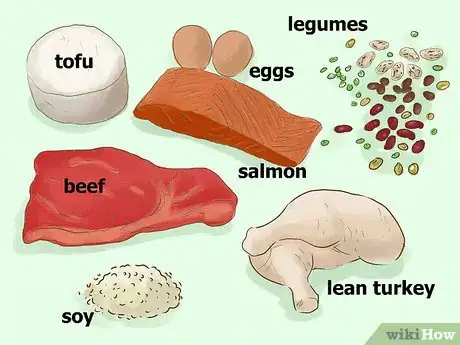
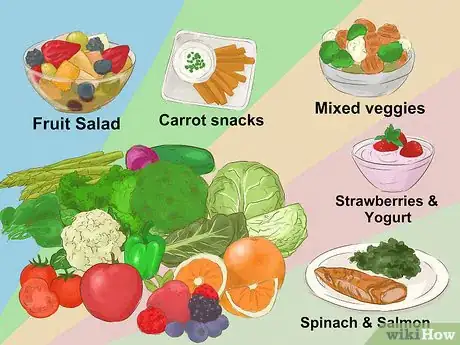
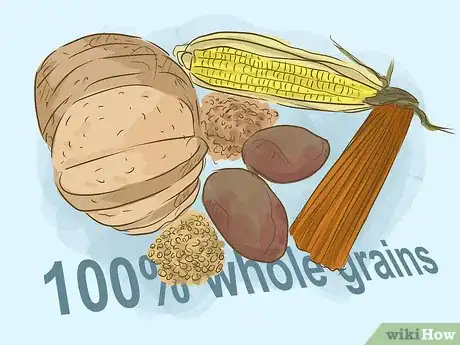
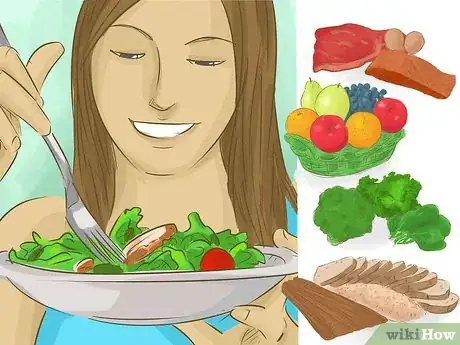
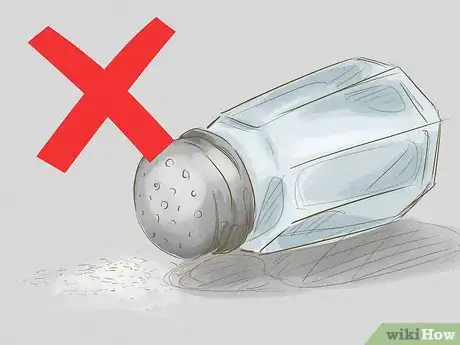
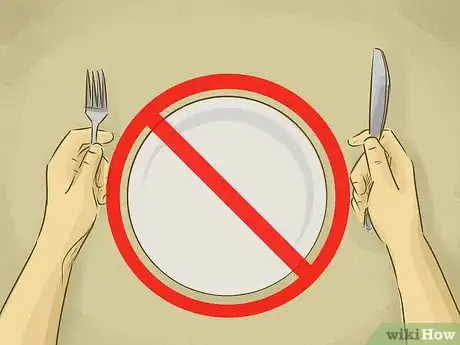
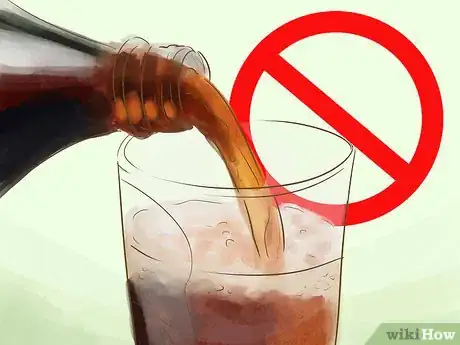


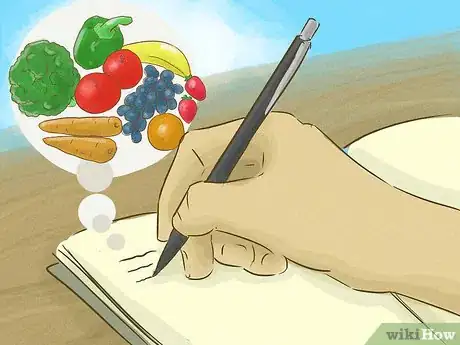
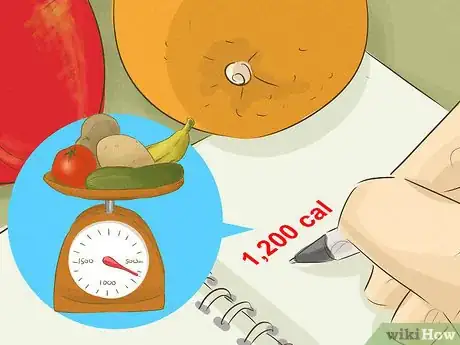
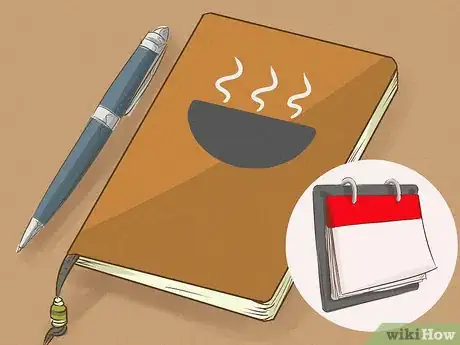




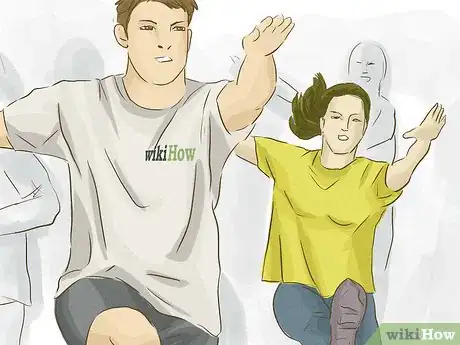
-Step-11-Version-3.webp)
